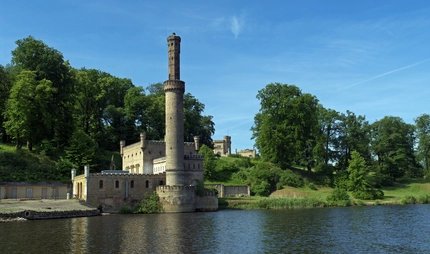
Historical Mill in Park Sanssouci
History and grain processing
Potsdam's historical mill is in opulent gardens near Baroque castles: experience a technical museum of a very special kind in Sanssouci Park.
If you look up the name "Müller" in the Berlin telephone book, you will find an astonishing 7938 records. This unusually high number shows that Berlin and its surroundings were once dominated by mills. In the mid-18th century for example, Potsdam is home to 21. One of them is the Historical Mill in Park Sanssouci. Already out of operation in 1858, it burns down in 1945 during the last days of the war. Following its reconstruction, it reopens in 1993 in the same location. Since then, visitors have been able to learn interesting facts about the history and technology of grain processing in this traditional building. Experience the process of grinding, sifting and filling before your eyes.

A visit to a production museum
From a distance you see the wings of the Historical Mill in Park Sanssouci turning slowly in the wind. As you approach, you will hear the rattling of the grinder. Before the entrance, you see the wild vines that climb the walls and frame the windows. The first thematic area is situated on the ground floor. The permanent exhibition deals with mills in Potsdam's cultural landscape. Take the spiral staircase to the first level where exhibits reveal the techniques employed by the traditional windmill. On the next floor, you learn about the history. A mill site since 1738, the original is replaced in 1791 by a Dutch mill. From 1861, it serves only as a museum until its destruction in 1945. The historical mill seen today is rebuilt between 1983 and 1993 after the old model. Enriched with knowledge, you enter the gallery where the wings of the mill turn slowly. Inside once again, proceed to the sifter, or meal floor. Then climb a wooden staircase to the grinding or stone floor and, at the top, the attic. Once a normal place of work, the mill at all levels has a pleasant, nostalgic flair: the creaking of the floorboards and the smell of wood conjure an authentic atmosphere. The gears and grinders have a home-made touch. Flour dust litters this ancient technology, as it does in the gallery. You can also enjoy the panoramic views of Sanssouci Park from high above.
Special features of the historic mill
- Permanent exhibition about mill craft (on the 1st floor)
- Permanent exhibition about the history of the mill in Potsdam (on the 2nd floor)
- Permanent exhibition about maintenance of the mill (on the gallery floor)
- Work station with hand rotating mill and sifting table for use by visitors (on the sifter floor)
- Stone crane using a sandstone millstone (on the grinding floor)
Heavenly castles of Sanssouci
Once in the area, a trip to Sanssouci Palace is worthwhile. Just a short walk through the park, you can't miss it. The Rococo-style castle is built by King Frederick between 1745 and 1747 on the vineyard terraces. The motto of the pleasure palace "Sans Souci" means "without worry". A walk of approximately 36 minutes brings you to the Lustschloss Belvedere. The magnificent double tower system in the style of an Italian Renaissance Villa has crowned the Pfingstberg Hill since 1863. From here, you are afforded a breathtaking view over Potsdam.
Our tips to visit the historic mill
The buses 614, 650 and 695 stop almost right in front of the door. The Maulbeerallee stop is only 100 metres away.
open seasonally



